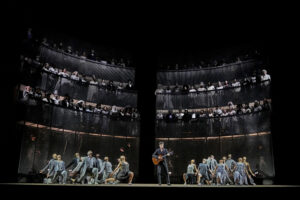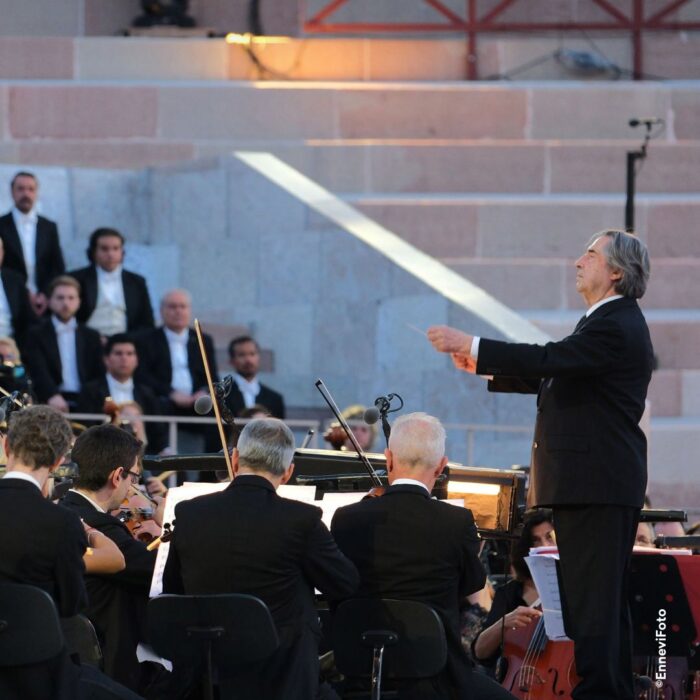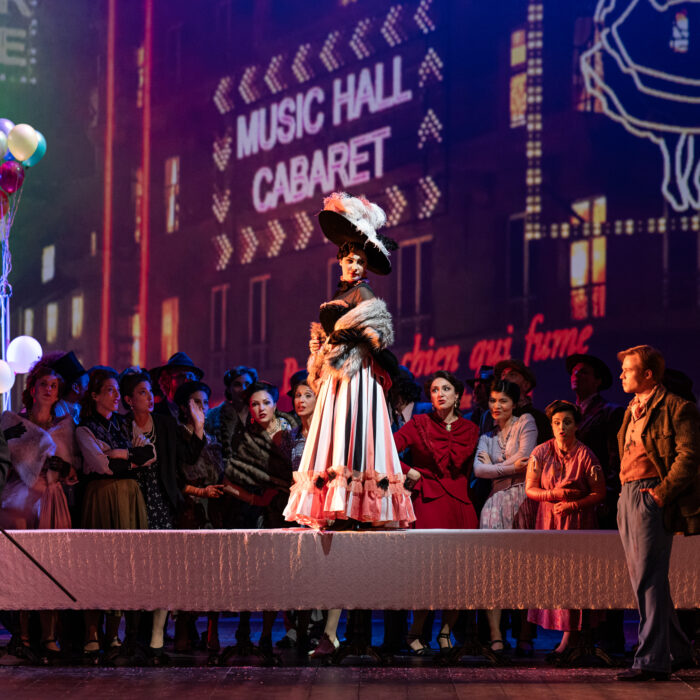
Metropolitan Opera 2023-24 Review: Orfeo ed Euridice
Anthony Roth Costanzo, Ying Fang, & Elena Villalón Shine in Marvelous Production
By David Salazar(Credit: Ken Howard)
The Met Opera’s production of Gluck’s “Orfeo ed Euridice” is as timeless as the work itself.
You couldn’t really ask for more from Mark Morris’ production, which is in the midst of a revival to close out the 2023-24 season. The two curved rafters converging to form a semi-circle at the center of the stage serve numerous functions, the primary one being to house the massive chorus. But they rotate as well, allowing the stage to open up and create differing configurations throughout the night. But what’s brilliant is that Morris never overdoes it in this respect, the shifts often subtle, never detracting from what is more important – creating a world through movement and stillness. The chorus, dressed up in a myriad of different visual archetypes or historical figures (I think one of them looked a lot of Abraham Lincoln), stands across three levels of the rafters, standing and sitting, but barely moving beyond that. At the ground level is the space for the dancers, who are constantly moving throughout the show; they initially wear only white or black as the furies before being decked in a wide range of colors at the conclusion of the opera. This contrast couldn’t be more potent and is perfect for an opera meditating on life and death and love as the unifying force of it all.
The only time when the stage shifts to something completely different is for the Act three confrontation between Orfeo and Euridice as they make their way up a narrow path amid a dark tunnel. The cavernous space creates a sense of isolation and dread at the most pivotal dramatic moment of the work. The constricted space thus provides a focus for the viewer and an expectation that there won’t be more of the action that has so defined the opera’s presentation to this point. It’s a brilliant piece of stage directing.
But this attention to detail was borne out in the lead performers, each with a different physical language throughout. Where Elena Villalón’s Amore was playful, beaming, and constantly mugging and flirting with others on stage, Anthony Roth Costanzo’s Orfeo was stoic and firm in his physicality, the moves almost choreographed in many instances, emphasizing Orfeo the musician through the music of body language. Only near the end of the opera, when all was lost, did Costanzo’s Orfeo lose that sense of coordinated physicality, almost as if wrestling with his loss of control. Meanwhile, Ying Fang’s shifted around the stage throughout the confrontation with Orfeo, trying to meet his gaze, win his favor, and understand what exactly was going on. It contrasted beautifully with Costanzo’s rigidity, adding to the visual tension of the scene.
Under conductor J. David Jackson, this sense of coordination stretched to the musical approach. While there was potency in the overture of the opera, there was a sense of restraint, the music gentle even in its most ferocious moments. It definitely favored the singers, allowing them to also take a correspondingly delicate vocal approach to the music. Costanzo was able to pull off some glorious mezzo di voce on long straight tones; one of the finest examples of this was near the end of the opera when Orfeo contemplates killing himself. At this moment, the countertenor delivered a potently unique delicate thread of straight tone, creating the effect of both a final breath and a pained yearning. There was something primal about the effect that I will never forget. He created another similarly arresting moment of mezza di voce on a straight tone at the end of the second verse of “Chiamo il mio ben.” Another fascinating aspect of that aria was Costanzo’s varied intensity of his vibrato throughout the aria, almost as if this ubiquitous aspect of a vocal line was being used more as a musical ornament to express varying degrees of emotion.

(Credit: Ken Howard)
One of Costanzo’s standout moments followed the second death of Euridice. Throughout the duet, the countertenor matched his counterpart vocally, line for line, delivering some of his roundest and most powerful vocal interjections throughout the evening. It expressed how his love for Euridice gave Orfeo a different energy and life. But after turning to see her and watching her die again, his voice diminuendoed to a thin thread of sound. You could feel the sense of shock. With each successive line of recitative, his countertenor grew in power, the vibrato wider, a passage-long crescendo that included some guttural low notes. It set up the glorious “Che farò senza Euridice” splendidly.
But that’s where things got a bit confusing for me. He started the aria with a delicate sound with minimal vibrato. It sounded airy, but as it was the start of the aria, there was room for build. But within moments, on the E5 on “che farrò senza il mio ben,” the countertenor put a massively vibrated and accented tenuto on the note, shifting gears from a piano line to a sudden forte line that sounded more at home in a romantic opera than in Gluck. But by the end of the phrase, he was back to the initial piano sound. There’s an internal logic to the rise and fall of the musical line and even the emotional intent, but stylistically it felt like two different musical worlds colliding in across 11 measures. And the collisions continued throughout the rest of the aria with Costanzo jerking the line from one stylistic approach to another, sometimes within phrases and even across adjacent notes. Each time he returned to that initial melody the intent seemed to shift around, starting forte and then shifting to piano where he had gone for the more intense forte approach. There wasn’t a clear musical build across the piece and the effect did feel a bit like musical whiplash throughout. Nonetheless, given the clarity of his musical intent throughout the rest of the night, there had to be some internal logic to the approach. Personally, I think that Costanzo’s aim for the famed aria was to show the contrasting feelings that Orfeo was feeling in that moment. Anger with himself. Anger with the fates. Despair. Pain. Frustration. Longing. Confusion. And often in our most tragic moments, these emotions get jumbled together and we jump from one to the other sporadically. That was the only way that I could comprehend the mélange of styles and musical leaps that the countertenor took throughout this piece.
As Euridice, Ying Fang was sublime, her sound projecting gloriously into the Met’s massive auditorium. “Che fiero momento” was passionate, the soprano’s voice blooming with each of the numerous ascending lines throughout the aria, the high A5’s delivered with vibrancy. Throughout the duet, her vocal intensity grew before, suddenly, toward the end, as she begged Orfeo to be open with her, it turned into the most gentle of pleas.
On the other end of the spectrum was Elena Villalón’s endearing Amore. Descending from the rafters, the soprano sang with brilliance throughout, and a noticeable spunk. Even when she wasn’t singing there was no doubt she was enjoying herself, providing the scene with its only ray of sunshine. The audience couldn’t get enough of her and you could hear laughter in response to her numerous antics. This is another example of genuinely brilliant directing in the production. There is no need to play Amore in this way and there are plenty of productions that portray the character as equally serious as other characters. But the levity provides a much-needed contrast to the somber nature of the opera’s world. Amore is life and life is vibrant. Villalón captured that joie de vivre in her rendition.
Gluck’s masterpiece is one of the great operas. And the Met’s production is an optimal complement for it. Couple that with this cast and this is definitely an ideal capstone to the company’s 2023-24 season.


